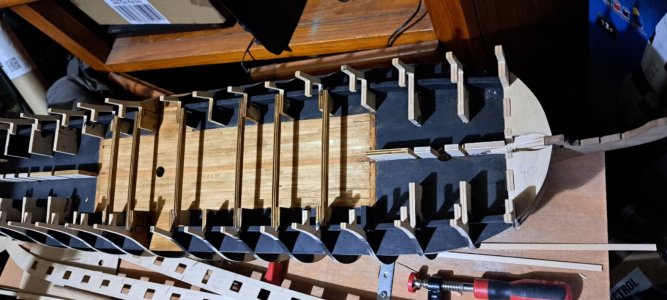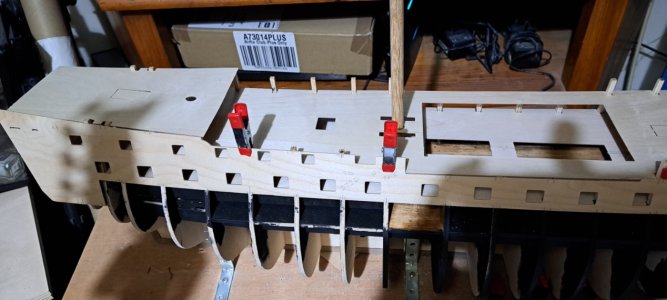- Joined
- Oct 25, 2022
- Messages
- 36
- Points
- 68

This is the false lower gun deck with the planking I've done so far. OK, so its not perfect, so here is my mitigation.
This is my first ever attempt at proper deck planking, and I had no idea even after experimenting how I was going to get around some quite important issues. So I just bit the bullet and went for it.
Also only a small percentage of this deck will ever be seen once the ship is complete. The manual calls out that only a part of this deck be planked but in order to get my self experienced in this Im doing the whole of this deck. The manual also calls for it to be fitted first and then planked. Not on my watch!
Plank length. Should be 85mm x 4mm according to the manual so I had a colleague at work 3D print me a pattern for cutting planks at 80mm, 85mm and 90mm, all at 3mm and 4mm widths. A colleague at work very kindly 3d printed a design for a plank length cutting gauge, various lengths and for two widths. However I didn't allow for shrinkage of the printed gauge ( I didn't even consider shrinkage as I had no idea it would shrink).and it shrunk enough to give me less than 85mm and 4mm width planks do no fit it the 4mm gauge recess. They did for a while but then they didn't.
Cutting: I bought a really flimsy cutter. The handle flexed like a flag in the wind when tryin' to chop me wood up! However, a slight mod to this has made the handle stiffen to a degree where the planks can be cut with a decent 90 deg. angle ( I superglued lolly sticks into the recesses of the cutting handle and that stiffened it enough.
Colour of the planks: Easy, I used Colron Geogian Medium Oak wood stain, The reason for staining rather than varnish is that after all this is done I'm going to have to sand this all down flat and so it will probably need staining again. Theres only one coat of stain on each plank. The stain is quite dark but then that deck would be a rather dark part of the ship I would think. Subsequent decks will be lighter
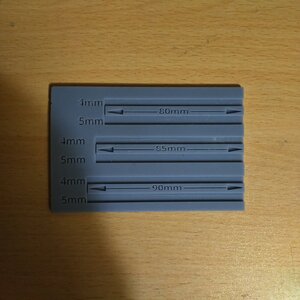
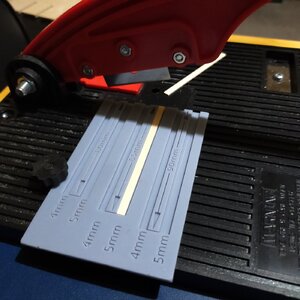
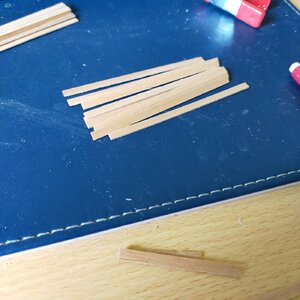
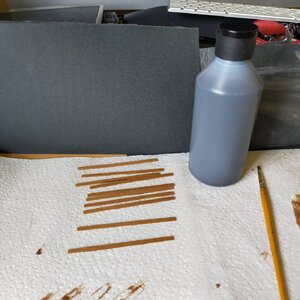
The false deck so far .....
Caulking: Using the brick layers technique, of using a line of thread to give me straightness. I laid thread (with some tension) across the length of the deck using the planks as width markers, in the photo's there is one either side of the planks laid. The thread also then becomes the caulking, or at least the first layer to give me the gap to run another line on top and in between the lines of planks. (The plan here is to drizzle some extra thin super glue to soak into the thread to make it hard and sandable.)
The only unsolved issue I have is how to caulk the butt joints. Where I did attempt it I used black paper but soon gave up on that, too fiddly. so I decided not to bother but for the next two decks that go on it needs to be solved. They need to be more or less perfectly done.
The important thing here that quickly became apparent was to lay the planks in between the lines of thread and not to butt the sides of the planks together. Lay them inbetween the lines of thread and they will be straight. Tacked down with wood glue and when the "big drizzle" of this extra thin superglue happens then it should soak doen into the wood fibres and consolidate the bond of the panks to the deck.
Four butt shift pattern: Complicated but I think I've done it right. There are 5 pencil lines running across the width of the deck that are 17mm apart. Each row is lined up against thes lines in the pattern that I believe to be correct shift pattern.
All the planks are 4mm wide, give or take a few hundred microns, to allow for natural wood imperfections. The exeption to this is the centre plank which is 6mm wide. I did this to allow for the width of the false keel slots and the 4mm planks go either side in a mirror image pattern.
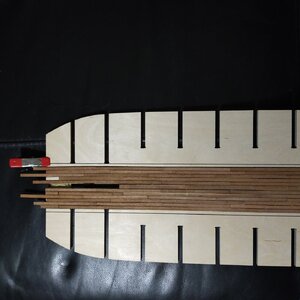

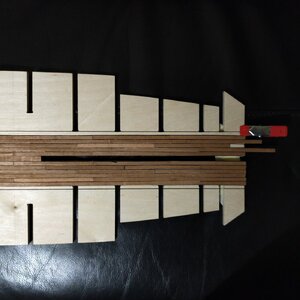
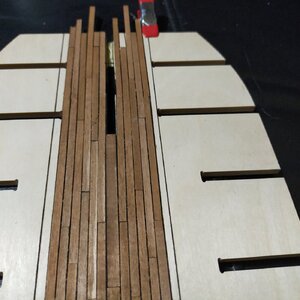
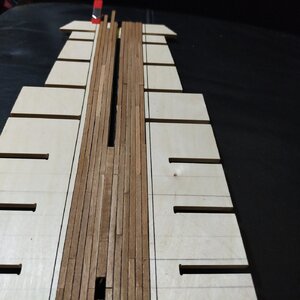
So, thats where I am right now, A few more weeks of just laying this little lovelies down and it can be trimmed, fitted and glued.
Im ever so sorry this is so long but I hope that it's interesting.
Cheers.
This is my first ever attempt at proper deck planking, and I had no idea even after experimenting how I was going to get around some quite important issues. So I just bit the bullet and went for it.
Also only a small percentage of this deck will ever be seen once the ship is complete. The manual calls out that only a part of this deck be planked but in order to get my self experienced in this Im doing the whole of this deck. The manual also calls for it to be fitted first and then planked. Not on my watch!
Plank length. Should be 85mm x 4mm according to the manual so I had a colleague at work 3D print me a pattern for cutting planks at 80mm, 85mm and 90mm, all at 3mm and 4mm widths. A colleague at work very kindly 3d printed a design for a plank length cutting gauge, various lengths and for two widths. However I didn't allow for shrinkage of the printed gauge ( I didn't even consider shrinkage as I had no idea it would shrink).and it shrunk enough to give me less than 85mm and 4mm width planks do no fit it the 4mm gauge recess. They did for a while but then they didn't.
Cutting: I bought a really flimsy cutter. The handle flexed like a flag in the wind when tryin' to chop me wood up! However, a slight mod to this has made the handle stiffen to a degree where the planks can be cut with a decent 90 deg. angle ( I superglued lolly sticks into the recesses of the cutting handle and that stiffened it enough.
Colour of the planks: Easy, I used Colron Geogian Medium Oak wood stain, The reason for staining rather than varnish is that after all this is done I'm going to have to sand this all down flat and so it will probably need staining again. Theres only one coat of stain on each plank. The stain is quite dark but then that deck would be a rather dark part of the ship I would think. Subsequent decks will be lighter




The false deck so far .....
Caulking: Using the brick layers technique, of using a line of thread to give me straightness. I laid thread (with some tension) across the length of the deck using the planks as width markers, in the photo's there is one either side of the planks laid. The thread also then becomes the caulking, or at least the first layer to give me the gap to run another line on top and in between the lines of planks. (The plan here is to drizzle some extra thin super glue to soak into the thread to make it hard and sandable.)
The only unsolved issue I have is how to caulk the butt joints. Where I did attempt it I used black paper but soon gave up on that, too fiddly. so I decided not to bother but for the next two decks that go on it needs to be solved. They need to be more or less perfectly done.
The important thing here that quickly became apparent was to lay the planks in between the lines of thread and not to butt the sides of the planks together. Lay them inbetween the lines of thread and they will be straight. Tacked down with wood glue and when the "big drizzle" of this extra thin superglue happens then it should soak doen into the wood fibres and consolidate the bond of the panks to the deck.
Four butt shift pattern: Complicated but I think I've done it right. There are 5 pencil lines running across the width of the deck that are 17mm apart. Each row is lined up against thes lines in the pattern that I believe to be correct shift pattern.
All the planks are 4mm wide, give or take a few hundred microns, to allow for natural wood imperfections. The exeption to this is the centre plank which is 6mm wide. I did this to allow for the width of the false keel slots and the 4mm planks go either side in a mirror image pattern.





So, thats where I am right now, A few more weeks of just laying this little lovelies down and it can be trimmed, fitted and glued.
Im ever so sorry this is so long but I hope that it's interesting.
Cheers.






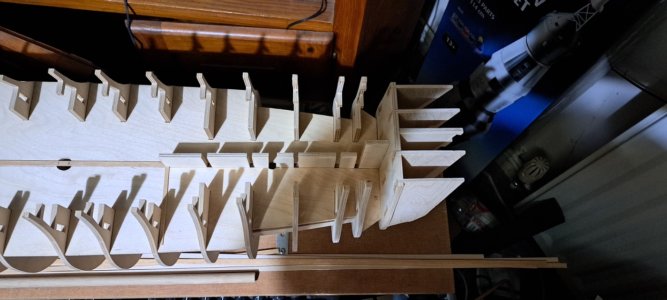

![20250302_142425[1].jpg 20250302_142425[1].jpg](https://shipsofscale.com/sosforums/data/attachments/489/489950-6dcbd408a2910354a1db85cbd1d4e4b3.jpg?hash=GM1Q_rIjen)
![20250309_080926[1].jpg 20250309_080926[1].jpg](https://shipsofscale.com/sosforums/data/attachments/489/489951-3cd9a4baaaa02dad9f8f6d9903757925.jpg?hash=PGvWtRj_CI)
![20250309_081001[1].jpg 20250309_081001[1].jpg](https://shipsofscale.com/sosforums/data/attachments/489/489952-af4180bda4c81a0222dd3c019c1f8e8b.jpg?hash=2Zd6lWSrBq)
